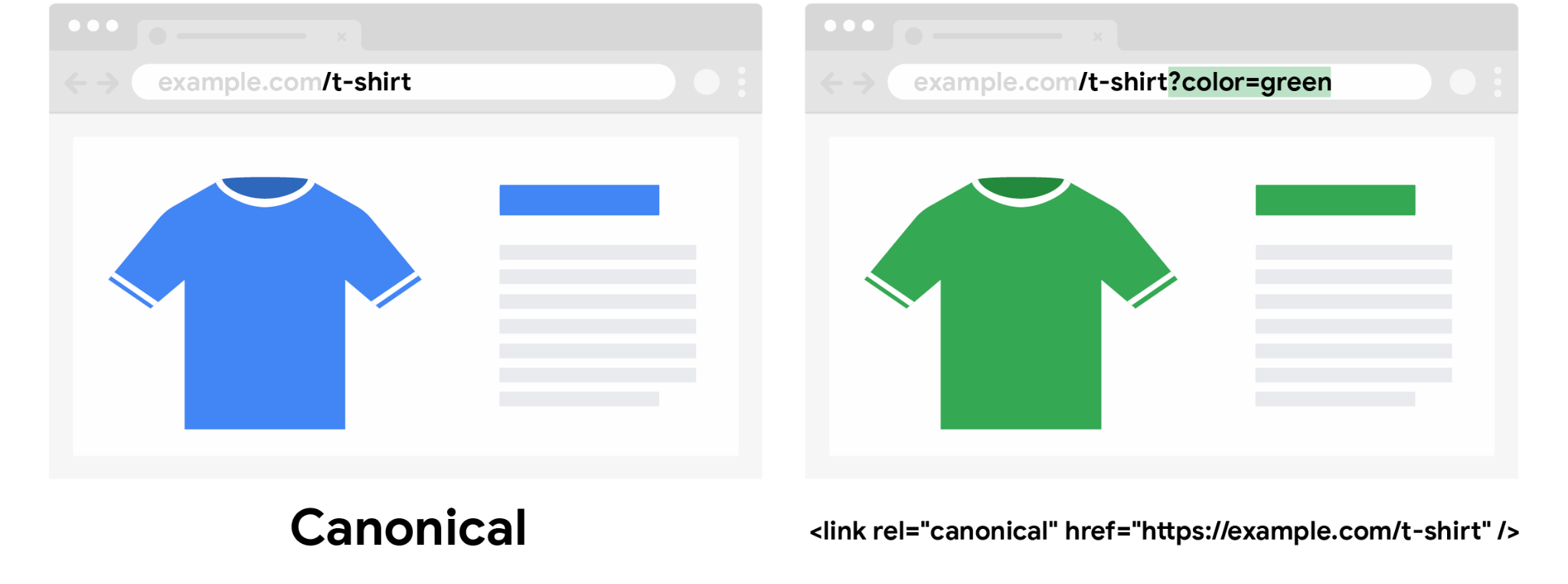E-ticaret web siteleri için URL yapısı tasarlama
İyi tasarlanmış URL'ler, Google'ın e-ticaret sitenizdeki web sayfalarını daha verimli bir şekilde bulup getirmesine yardımcı olabilir. URL'lerinizin yapısını kontrol edebiliyorsanız (örneğin, kendi web sitenizi sıfırdan geliştiriyorsanız) Google'ın e-ticaret sitelerinde karşılaştığı dizine ekleme sorunlarını önleyecek bir URL yapısı belirlemek için bu kılavuzdan yararlanabilirsiniz.
URL yapısının önemi
İyi bir URL tasarım yapısı Google'ın sitenizi tarayıp dizine eklemesine yardımcı olurken, kötü bir URL yapısı aşağıdaki sorunlara yol açabilir:
-
Googlebot yanlışlıkla iki URL'nin aynı içeriği döndüreceğini düşünürse URL'lerden yalnızca birini (diğeri kopya olarak elenir) alabileceği için atlanan içerikler olabilir. Bu durum, farklı içerikleri göstermek için parça tanımlayıcıların (
#fragmentgibi) kullanılmasından kaynaklanabilir. Google, dizine eklemede parça tanımlayıcıları kullanmaz.Örnek:
/product/t-shirt#blackve/product/t-shirt#white, Google tarafından aynı sayfa olarak değerlendirilir. -
Google, aynı sayfayı döndüren iki URL'nin farklı olduğunu düşünürse tarayıcı tarafından aynı içerik birçok kez alınabilir. Bu durum, sitenizin tarama hızını yavaşlatıp gereksiz yere web sunucunuzun yükünü artırabilir.
Örnek:
/product/black-t-shirtve/product?sku=1234aynı ürün sayfasını döndürebilir ancak Google yalnızca URL'ye bakarak bunu tespit edemez. -
URL'leriniz zaman damgası gibi sürekli değişen bir değer içeriyorsa tarayıcı, sitenizde sınırsız sayıda sayfa olduğunu düşünebilir. Sonuç olarak Google'ın sitenizdeki faydalı içeriklerin tamamını bulması daha uzun sürebilir.
Örnek:
/about?now=12:34amve/about?now=12:35amaynı sayfayı gösterse de Google tarafından farklı URL'ler olarak değerlendirilebilir.
Google'ın sitenizi nasıl tarayıp dizine eklediği hakkında daha fazla bilgi için Google Arama Nasıl Çalışır? ve Google'ın Tarayıcıları Sitenizi Nasıl Dizine Ekler? konularını inceleyin.
İyi bir URL yapısı tasarımıyla ilgili en iyi uygulamalar
Google'ın sitenizi tarama ve dizine ekleme şeklini optimize etmek için URL'lerinizi nasıl yapılandıracağınız konusunda buradaki en iyi uygulamaları takip edin.
Genel URL önerileri
- Google'ın sitenize gereğinden fazla istek yapmasını engellemek için, aynı içeriği döndüren alternatif URL sayısını mümkün olduğunca azaltın. Google, iki URL'nin aynı sayfayı döndürdüğünü ikisi de alınmadan önce fark edemeyebilir.
- Web sunucusunda URL'lerdeki büyük ve küçük harf kullanılan metinler aynı şekilde işleniyorsa, Google'ın aynı sayfaya işaret eden URL'leri daha kolay belirleyebilmesi için tüm metinleri tamamen büyük harf veya tamamen küçük harf kullanacak şekilde değiştirin.
- Sayfalara ayrılmış sonuçlarda her sayfanın benzersiz bir URL'si olduğundan emin olun. En fazla URL hatasını sayfalara ayrılmış URL yapılarında görüyoruz.
-
URL yollarına açıklayıcı kelimeler ekleyin. URL'lerdeki kelimeler, Google'ın sayfayı daha iyi anlamasına yardımcı olabilir.
Önerilen:
/product/black-t-shirt-with-a-white-collarÖnerilmeyen:
/product/3243
URL sorgu parametresi önerileri
Google'ın sitenizi başarılı bir şekilde tarayıp dizine eklemesine yardımcı olmak için sorgu parametreleri kullanırken bu önerilere uyun.
-
Mümkün olduğunda
?valueyerine?key=valueURL parametrelerini kullanın. URL parametreleri, Google Arama'nın sitenizin yapısını anlamasına ve sitenizi daha verimli bir şekilde tarayıp dizine eklemesine imkan sağlar.Önerilen:
/photo-frames?page=2,/t-shirt?color=greenÖnerilmeyen:
/photo-frames?2,/t-shirt?green -
Aynı parametreleri iki kez kullanmaktan kaçının. Aksi takdirde Googlebot bu değerlerden birini yoksayabilir.
Önerilen:
?type=candy,sweetÖnerilmeyen:
?type=candy&type=sweet -
Oturum kimliği, izleme kodu, kullanıcıya bağlı değerler (
location=nearby,time=last-week), anlık saat vb. geçici parametrelere dahili bağlantı vermekten kaçının. Bu durum, URL'lerin kısa ömürlü olmasına veya aynı sayfa için kopya URL'ler oluşmasına neden olabilir. Google Arama'dan en iyi sonuçları elde etmek için uzun vadeli, kalıcı URL'ler kullanın.Önerilen:
/t-shirt?location=UKÖnerilmeyen:
/t-shirt?location=nearby,/t-shirt?current-time=12:02,/t-shirt?session=123123123
Google, ürün varyantları ile ilgili URL'leri nasıl anlar?
Birden çok boyutta veya renkte satışa sunulan ürünler için URL'lerin nasıl yapılandırılacağı, e-ticaret sitelerinde yaygın olarak değerlendirilen konulardandır. Ürün özelliklerinden oluşan her kombinasyon, bir ürün varyantı olarak adlandırılır. Google'ın ürün varyantlarınızı anlamasına yardımcı olmak için her varyantın ayrı bir URL ile tanımlanabildiğinden emin olun. Varyant URL'leri için aşağıdaki URL yapılarını öneririz:
-
/t-shirt/greengibi bir yol segmenti -
/t-shirt?color=greengibi bir sorgu parametresi
Daha fazla bilgi için ürün varyantı yapılandırılmış veri belgelerine bakın.
Varyantları tanımlamak için isteğe bağlı sorgu parametreleri kullanıyorsanız, sorgu parametresi içermeyen URL'yi standart URL olarak kullanın. Böylece Google, ürün varyantlarınız arasındaki ilişkiyi daha iyi anlayabilir.

İçeriğinizde URL'leri kullanma
Ürünlerinizin ve ürün varyantlarınız arasındaki ilişkinin Google Arama ile Google Alışveriş tarafından doğru tanımlanabilmesi için, içeriğinizde URL'leri kullanırken bu en iyi uygulamaları izleyin.
-
Dahili bağlantılar, site haritası dosyaları ve
<link rel="canonical">etiketlerinde aynı URL'yi kullanın. Örneğin, varsayılan sayfa ilk sayfa olacak şekilde sayfalara ayrılmış bir sıralamada sorgu parametresiyle ilk sayfaya bağlantı verirken URL'deki?page=1değerini tutarlı bir şekilde site genelinde dahil edin ya da hariç bırakın. -
Dizine eklenebilen tüm sayfalarda kendine işaret eden bir
<link rel="canonical">etiketi (etiketteki URL'nin mevcut sayfaya işaret edeceği şekilde) kullanın ve bu URL'leri bir sitemap dosyasına ekleyin. -
Her varyantı için benzersiz bir URL bulunan ürünlerde,
<link rel="canonical">etiketi kullanarak standart ürün URL'sini tüm varyant sayfalarına ekleyin. Daha fazla bilgi için Google Merchant Center'ıncanonical_linközelliğini inceleyin. -
Sayfalar arasında gezinmek için JavaScript kullanmayın;
<a href>etiketlerini kullanarak bağlantıları doğrudan sayfalara ekleyin. Googlebot, JavaScript kodu kaynaklı gezinmeyi algılamayabilir. Google'ın JavaScript'i nasıl işlediği hakkında daha fazla bilgi için JavaScript SEO temel kavramlarını anlama konusuna göz atın. -
Mümkün olduğunda
<a href>ve</a>etiketlerinin arasına, bağlantı verilen ürünün başlığı gibi anlamlı metinler ekleyin. "Burayı tıklayın" gibi genel ifadeler kullanmayın. -
İşe yarar içerik bulunmayan sayfalara bağlantı vermekten kaçının veya en azından bu sayfaların dizine eklenmesini engelleyin. Hiç öğe içermeyen kategoriler için
noindexrobotsmetaetiketi kullanın. Sitenizde boşaldığı tespit edilen kategoriler otomatik olarak site içi aramadan ve göz atmadan kaldırılıyorsa bu sayfalar için404 (not found)HTTP durum kodu döndürmeyi değerlendirin.
Ek kaynaklar
Daha fazla bilgi edinmek ister misiniz? Aşağıdaki kaynaklara göz atın:
